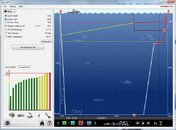Thank YouVery impressive - I'm interested in your dive planning products......
NO!.....If I understand you correctly, you are saying the OP should be okay with his original dive plan, as laid out in posts #1 and #4, assuming "typical multilevel profiles with 3 minutes safety stops"....
What I said was that I plugged-in the OP 24 dives in divePAL using "Square Root" shaped profiles that I made up (descend at 60ft/min to the max depth, stay there few minutes, then ascend to the surface at 30ft/min - stopping here and there for a bit (like a recreational diver would do) - and then make the final safety stop at 15ft for 3 minutes). No one knows if the OP will actually follow those profiles or not.
Based on the profiles I made up, the level of slowest compartment at the end of the 24 dives sequence was ~75% (again, if you change the shape of the profiles a tiny bit, all the bets are off).
I don't know. I am not a doctor. I just like to crunch numbers.......My question is, does he need to completely desaturate before boarding an airplane? If not, how long would he have to wait in order to board an airplane?.....
Alberto (aka eDiver)





